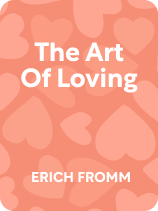

This article is an excerpt from the Shortform book guide to "The Art of Loving" by Erich Fromm. Shortform has the world's best summaries and analyses of books you should be reading.
Like this article? Sign up for a free trial here .
What is false love? What are the different categories of false love?
False love is when people pursue a connection for reasons such as sexual desire or a financial partnership. Although a real love relationship can include these things, they should not be the base of a relationship.
Continue below to learn about the different types of false love.
False Love: Defined
What is false love? To Fromm (the author of The Art of Loving), the most common way that modern people pursue connection is through false love. Fromm believes that false love is more common than genuine love in modern society because of the rise of capitalism, which requires people to turn their energy into a tradable good in the form of labor: They give labor and get money in return. As a result, we’re less inclined to give ourselves freely; the idea of giving someone time and energy without getting anything in return (which is an expression of genuine love) has become unthinkable. Instead, we practice false love, in which we only give affection in order to get something in return.
(Shortform note: While Fromm argues that all transactional relationships must be forms of false love by default, other psychologists argue that genuine love must include some measure of reciprocity. In that view, giving someone endless time and energy without expecting anything in return is an unhealthy practice. Instead, genuinely loving relationships should be interdependent: Both partners should be able to count on receiving affection, attention, and trust from the other. This expectation isn’t rooted in capitalism—it’s rooted in the understanding that all healthy relationships require give and take.)
Types of False Love
Fromm describes a few main categories of false love. We’ll explore each of these categories below:
Love as Sexual Desire
This is the model of love that Sigmund Freud proposed, in which love is merely the expression of sexual desire—specifically, every man’s desire to sleep with every woman he possibly can. Freud believed that all other forms of love were diluted versions of this primary desire. According to Fromm, this empty desire is a form of false love because it doesn’t involve nourishment, responsiveness, acceptance, or genuine understanding.
(Shortform note: Other philosophers have a more charitable view of love as sexual desire. For example, the Greek philosopher Plato believed that, with effort, people could use the sexual desire they feel for one person to open their eyes to beauty in all its forms. People could then funnel this new awareness into genuine love for all of humanity: In other words, they could convert false love based on sexual desire into genuine Platonic love.)
Love as a Partnership
The second form of false love is the idea of love as a partnership, in which two people love each other solely to increase their odds of succeeding in a capitalist society. While they care for one another, their primary loyalty is still to themselves—they invest in the relationship because it serves their own purposes. This kind of love mimics a business partnership. For example, a man who gets married so he will have a wife to take care of the home while he focuses on work (or a woman who gets married so she’ll have a husband to provide for her economically) is pursuing this kind of false love.
(Shortform note: This form of false love is still prevalent in the 21st century; however, men and women approach these relationships differently. A survey of Harvard Business School graduates revealed that most men expect to prioritize their own careers over their wives’ careers. In contrast, the same survey found that most women expect a more equal relationship in which each partner supports the other’s career goals. However, while their vision of an ideal relationship differs, both men and women think a healthy relationship is one that helps them succeed as workers in a capitalist society.)
Love as Misplaced Parental Attachment
Another form of false love is misplaced parental attachment. When one or both partners have unresolved parental attachments, they’ll seek a form of parental love from each other rather than genuine romantic love. However, because romantic partners typically can’t give the type of maternal or paternal love these people crave, they’re inevitably disappointed with their romantic relationships.
(Shortform note: The science of attachment supports Fromm’s analysis. In Attached, Levine and Heller argue that children whose parents aren’t caring, responsive, and attuned to their needs often develop “insecure attachments,” meaning they have a hard time trusting other people. As adults, people with insecure attachments struggle with healthy romantic relationships, just as Fromm identified.)

———End of Preview———
Like what you just read? Read the rest of the world's best book summary and analysis of Erich Fromm's "The Art of Loving" at Shortform .
Here's what you'll find in our full The Art of Loving summary :
- Why you might be wrong about what you think of as love
- Why so many people are unhappy, despite having all their basic needs met
- How to genuinely love others to become happier and less isolated






